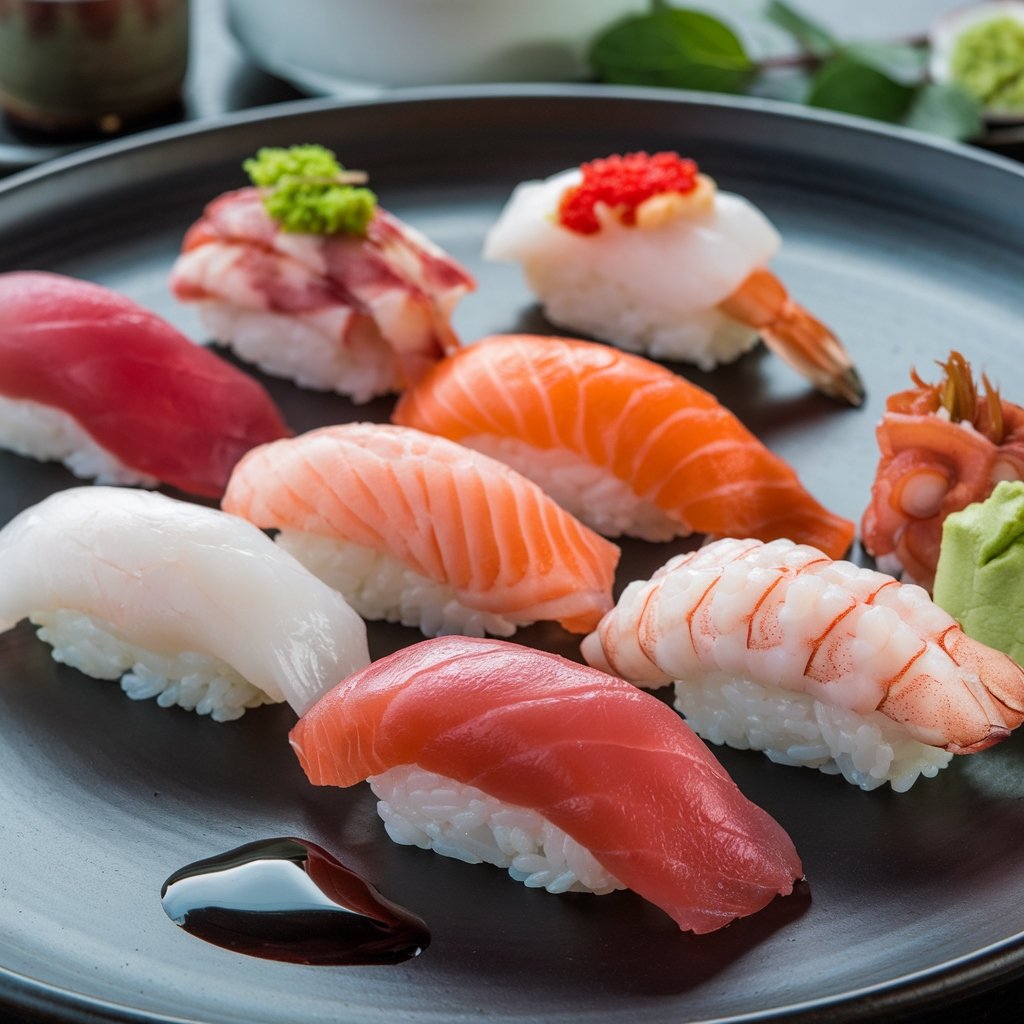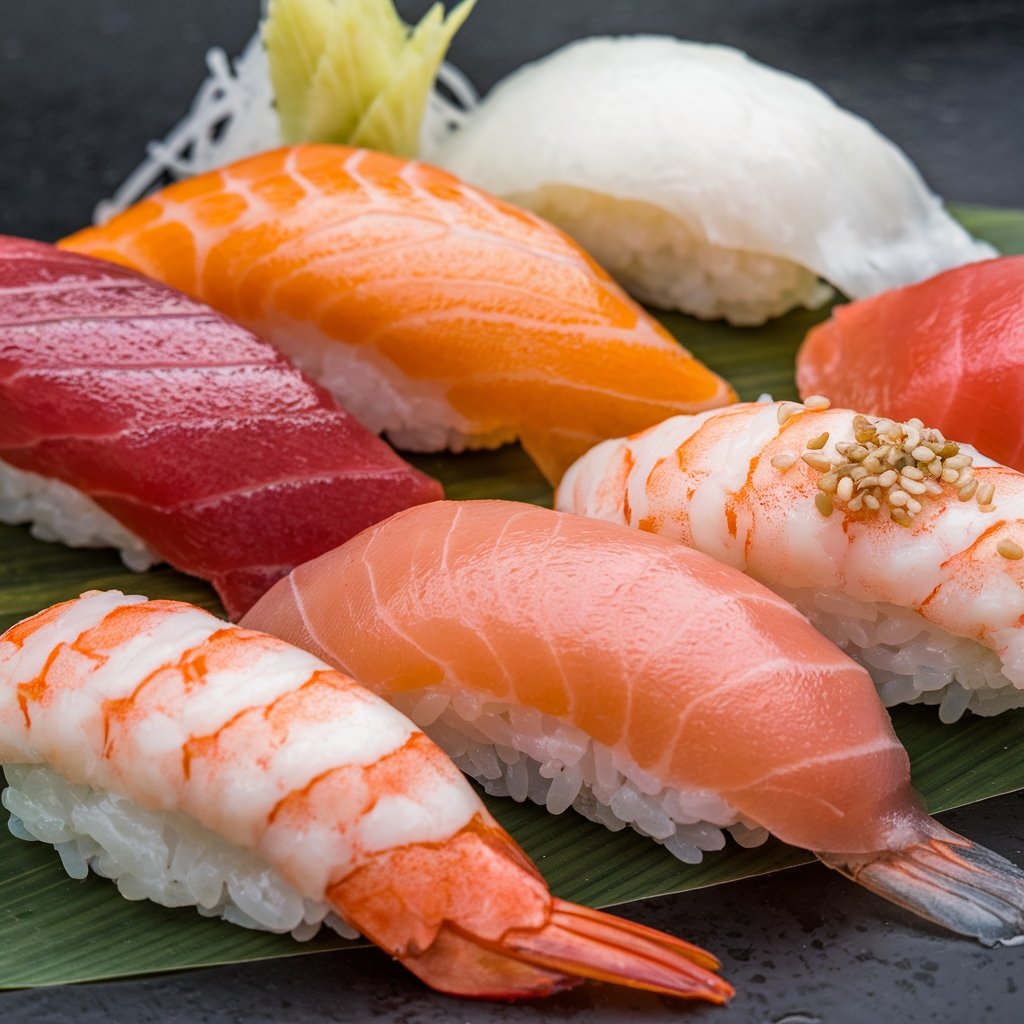With just two basic ingredients—vinegared rice and fresh fish or seafood— Nigiri is a masterwork of simplicity in the realm of sushi. Still, its grace, taste, and cultural value have made it a mainstay in sushi restaurants all around. Nigiri welcomes interest and appreciation regardless of your level of experience or love of food—sushi or else.
This page explores what nigiri is, its background, its artistic quality, and how it contrasts with other sushi varieties including sashimi. We will also discuss ways to fully enjoy nigiri, provide cooking methods, and address common issues to enable you to confidently negotiate this legendary cuisine.
What Is Nigiri?
A little hand-formed ball of vinegared rice topped with thinly sliced fish or seafood defines the nigiri style of sushi. From the Japanese word nigiru, which means “to grasp” or “to squeeze,” the phrase “nigiri” captures the hand-crafted shaping of the rice.
Nigiri is unique among other sushi varieties that could call for bowls or rolls (maki) in its simplicity. Its simplicity emphasizes the quality of the components, therefore transforming it from a culinary treat into an artistic medium.
The Art of Making Nigiri
Making nigiri goes beyond merely arranging fish on rice. It strikes a careful mix between taste, texture, and skill. The following distinguishes nigiri:
- Perfectly Seasoned Rice: Seasoned with rice vinegar, sugar, and salt, sushi rice—also known as shari—is Its sticky consistency holds the topping and gives nigiri its characteristic acidic taste.
- Fresh, High-Quality Toppings: Often raw, the fish or shellfish topping—also known as neta—can also be grilled, seared, or marinated. Among favorites are salmon, tuna, prawns, and eel.
- Hand-Crafted Precision: Learning to make rice balls with just the correct pressure helps sushi chefs maintain their compact yet soft texture.
Though at first glance Nigiri seems straightforward, reaching its delicate balance calls for years of experience and a thorough knowledge of sushi techniques.
Nigiri vs Sashimi: What’s the Difference?
One of the most often asked questions among those starting sushi is how nigiri differs from sashimi. Although both highlight fresh fish, their cooking and presentation techniques differ:
| Nigiri | Sashimi |
|---|---|
| Includes vinegared rice | Served without rice |
| Topped with fish or seafood | Thinly sliced fish or seafood only |
| Often garnished with wasabi or nori | Typically garnished with daikon radish |
| Considered a type of sushi | Not classified as sushi |
Nigiri then provides the best of both worlds: rice and fish in perfect harmony if you’re hankering after sushi but want something smaller than a roll.
Popular Types of Nigiri Sushi

About nigiri, diversity is essential. These are some of the most often-used varieties you’ll come across at sushi bars:
- Salmon Nigiri (Sake Nigiri): Salmon Nigiri is a crowd-pleasure with a creamy texture and subdued taste.
- Tuna Nigiri (Maguro Nigiri): A typical topping with its vivid red hue and meaty taste is tuna.
- Ebi Nigiri: Made with cooked prawns, this kind is ideal for beginners who would rather have a softer introduction to sushi.
- Unagi Nigiri: Sweet, grilled eel, unagi nigiri has a special mix of savory and smokey tastes.
- Hamachi Nigiri: Sushi buffs love the creamy, buttery taste of yellowtail fish.
A flexible and interesting sushi selection, each kind of nigiri represents diverse textures and flavors.
Tips for Enjoying Nigiri Like a Pro
To enjoy nigiri, a small bit of manners counts greatly. Enjoy nigiri like a sushi connoisseur here:
- Eat in One Bite: Nigiri is crafted to be consumed in a single bite to experience the blend of rice, fish, and wasabi.
- Dip the Fish, Not the Rice: When using soy sauce, lightly dip the fish side rather than the rice to avoid overpowering the flavors.
- Try It With Wasabi: Some nigiri already have a small dab of wasabi between the rice and fish. If you’re a fan of spice, you can add a little extra.
- Appreciate the Balance: Notice how the rice’s tanginess complements the fish’s freshness—this harmony is the hallmark of great nigiri.
The Role of Seasonal Ingredients in Nigiri
Nigiri is not an exception; seasonality is rather important in Japanese cuisine. Some fish are best eaten at particular times of the year when their flavor and texture shine. As follows:
- Spring: Fresh sea bream and baby squid.
- Summer: Delicate whitefish like flounder.
- Autumn: Fatty tuna and salmon roe.
- Winter: Sweet shrimp and mackerel.
Oysters, while not traditionally used in nigiri, are another delicacy that shines seasonally. Their briny, creamy flavor is perfect as a standalone dish or incorporated into other Japanese recipes. To learn more about seasonal oysters and their culinary potential, check out this guide to Ostiones (Oysters).
When dining at a sushi bar, don’t hesitate to ask the chef about seasonal specialties—they often highlight the freshest offerings of the day.
Common Challenges When Making Nigiri at Home

If you’re tempted to try making nigiri at home, you might encounter a few challenges. Here’s how to overcome them:
- Sticky Rice: Sushi rice can be tricky to work with. Keep your hands slightly damp to prevent sticking.
- Uneven Rice Balls: Practice makes perfect! Focus on using gentle but firm pressure to shape the rice.
- Finding Fresh Fish: Purchase sushi-grade fish from a trusted supplier to ensure quality and safety.
For an added twist, you can experiment with your flavors. While traditional nigiri focuses on fresh, clean tastes, adding unique seasonings can bring a creative spin to your sushi experience. Check out this Hillbilly Fish Fry Seasonings Recipe for inspiration—it’s a fantastic way to explore bold and unexpected flavors that complement seafood.
With patience and practice, you can recreate restaurant-quality nigiri in your kitchen.
Why Nigiri Sushi Is More Than Just Food
Nigiri is a cultural statement of Japan’s respect for simplicity, accuracy, and natural tastes, not only a meal. Every piece relates to a tale of balance, workmanship, and custom. Nigiri provides a unique glimpse into Japanese culinary philosophy regardless of your level of enjoyment—high-end sushi bars or casual venues.
One famous meal honoring the elegance of simplicity is nigiri. This sushi style never fails to enthrall foodies all around whether they are enjoying salmon nigiri at a sushi restaurant or investigating seasonal variety.
All set to personally discover the artistic brilliance of nigiri? See your neighborhood sushi restaurant, forward this page to friends, or learn more about Japanese cuisine on our blog!
